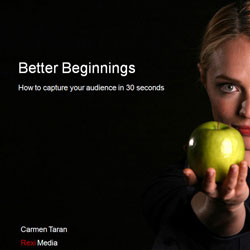Carmen Taran (now Simon), co-founder of Rexi Media, is on a mission—to prevent lackluster presentations. She wrote Better Beginnings: How to capture your audience in 30 seconds to teach others how to “get participants’ spines erect and minds engaged.” This book is for anyone who wants their audience, whether passive listeners or active learners, to remember their presentations (including all types of eLearning) for the right reasons.
 To achieve the goal of getting people engaged, you have to
capture their attention within the first 30 seconds. Is it really possible to
capture an audience in 30 seconds? Consider this: advertisers spent an average
of $3.4 million each to air 30-second commercials during 2012’s Super Bowl
XLVI. How much are you willing to invest
to get your audience’s attention?
To achieve the goal of getting people engaged, you have to
capture their attention within the first 30 seconds. Is it really possible to
capture an audience in 30 seconds? Consider this: advertisers spent an average
of $3.4 million each to air 30-second commercials during 2012’s Super Bowl
XLVI. How much are you willing to invest
to get your audience’s attention?
Techniques and tips
Simon asserts that so many presentations have become forgettable because they failed to use one or more of the following techniques: anticipation, specificity, inquiry, incongruity, novelty, uncertainty, complexity, ease of comprehension, indulgence, and staging. In the book, she devotes a section to each technique and provides tips on its usage (Table 1).
|
Technique |
What to Do |
|
Anticipation |
|
|
Specificity |
|
|
Inquiry |
|
|
Incongruity |
|
|
Novelty |
|
|
Uncertainty |
|
|
Complexity |
|
|
Ease of Comprehension |
|
|
Indulging |
|
|
Staging |
|
Implications for eLearning
Followers of Gagné’s nine events of instruction know the first step is to gain the attention of the learners. The charge to gain (and retain) their attention is even more challenging when it comes to eLearning. As developers, you have limited interaction with your audience—the learners who will be taking your training.
Therefore, you don’t get an opportunity to gauge the audience’s response to it. All you have is the course itself, not only when the course will be a stand-alone self-administered module, but even when an instructor will deliver it to distance learners in a virtual classroom. The content acts as your voice; it speaks to the learners on your behalf. Unfortunately, this communication is not a two-way street for the developer. Simon encourages developers to view the learners as having remote controls in their hands: They can shut off the training without notice.
Conclusion and recommendations
In the last section of the book, Simon reminds us that “A strong beginning is enhanced by a strong follow-through.” Those first 30 seconds you invested can lead to a return of 10 more minutes of the learners’ attention. Continue to use the techniques in Table 1 to sustain it. Better beginnings in your training can lead to better experiences for the learners.
I definitely recommend this book if you’re interested in developing more engaging eLearning interventions. The author practices what she preaches, incorporating the appropriate words and examples for each technique to keep the reader’s attention. If you happen to come across a presentation or webinar by the author, don’t hesitate to register for it.
Bibliographic information
Taran, Carmen. (2009). Better Beginnings: How to capture your audience in 30 seconds. Rexi Media. ISBN: 978-0-615-24520-1. 197 pages.
Note: The book is currently out of print; however, copies may still be available through Amazon or AbeBooks. You can also read an excerpt from Rexi Media’s website.

